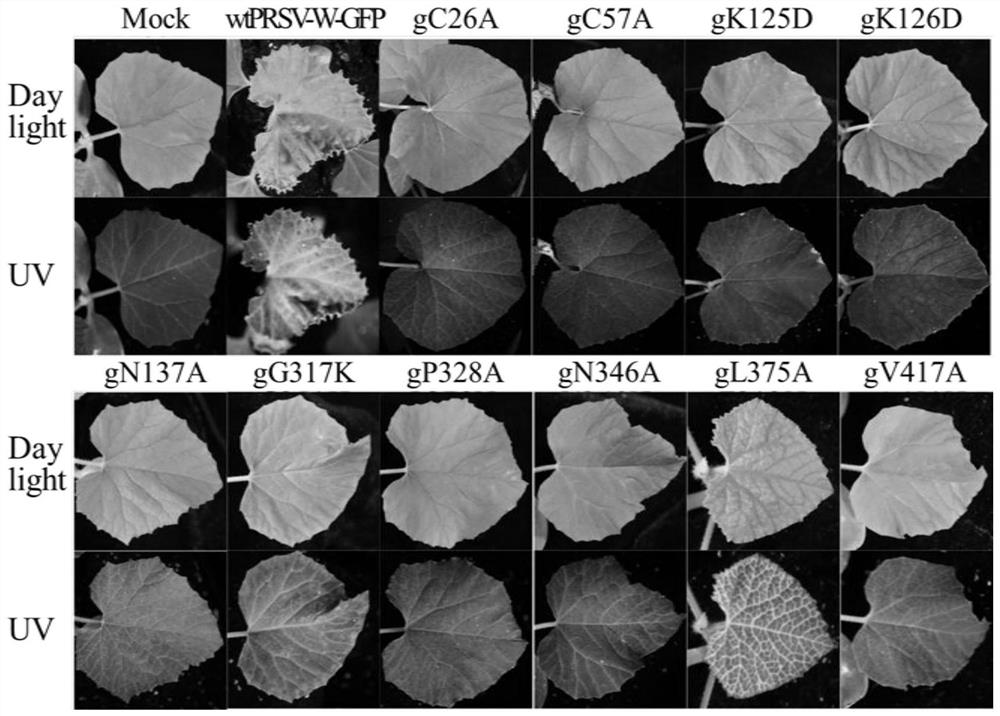Development and Application of Papaya Ringspot Virus Watermelon Strain Attenuated Vaccine
A ring spot virus and attenuated vaccine technology, applied in the field of genetic engineering, can solve the problems of poor protection and no protection of PRSV strains
- Summary
- Abstract
- Description
- Claims
- Application Information
AI Technical Summary
Problems solved by technology
Method used
Image
Examples
Embodiment 1
[0043] Example 1: Site-directed mutagenesis
[0044] Using the full-length invasive cDNA clone pCamPRSV-W-GFP of the papaya ringspot virus watermelon strain with a green fluorescent protein (green fluorescent protein, GFP) tag as a template, the mutation was carried out by PCR, and the DNA polymerase used was Phusion high-security true polymerase.
[0045] Mutation PCR reaction system:
[0046]
[0047] In the above mutation PCR reaction system, primer 1 and primer 2 can be the primers shown in SEQ ID No.1 and SEQ ID No.2, or the primers shown in SEQ ID No.3 and SEQ ID No.4, respectively,... Or the primers shown in SEQ ID No.19 and SEQ ID No.20 are used to mutate amino acids at different positions of HC-Pro.
[0048] PCR reaction program: 98°C pre-denaturation for 30s; 98°C denaturation for 10s, Tm no+3°C annealing for 20s, 72°C extension for 9min30s, 15 cycles; 98°C denaturation for 10s, Tmpp+3°C annealing for 20s, 72°C extension for 30min, Store at 4°C. Tm no and Tmpp...
Embodiment 2
[0050] Example 2: Inoculation of virus
[0051] Transform pCamPRSV-W-GFP and the mutant plasmid into Agrobacterium GV3101 competent cells. After colony PCR verification, pick a single spot and inoculate it in 2 mL containing kanamycin (50 μg / mL), rifamycin (50 μg / mL), In the liquid LB medium of tetracycline (5 μg / mL), shake culture at 180 r / min at 28° C. for 24 h. Add 500 μL of bacterial liquid to 5 mL of LB medium containing 10 mM 2-(N-morpholine)-ethanesulfonic acid (MES) and 20 μM acetosyringone (AS) and the same antibiotics as in the previous step, at 28 °C 200 r / min Shaking culture to the logarithmic growth phase takes about 12 hours. The bacteria were collected by centrifugation, and the resuspension (10mM MgCl 2 , 10mM MES, 0.15mM AS) gently resuspend the cells, adjust the OD 600 The value is 0.5-0.6, and it is allowed to stand at 28°C for 3 hours. Use a 10 μL pipette tip to pierce a small hole on the back of the cotyledon of the plant, use a 1mL needle-free medical...
Embodiment 3
[0052] Example 3: Symptom observation and virus accumulation level detection
[0053] On the 15th day after inoculation, the symptoms of the inoculated plants were observed, and the leaves of the system were collected to extract RNA and protein. RT-PCR was used to detect whether the mutant successfully infects the host, and the level of virus accumulation was detected by Western blotting. The wild-type PRSV-W with GFP tag caused severe symptoms such as mosaic, chlorosis, mottling and deformity on the leaves of muskmelon (Cucumis melo), and obvious green fluorescence was visible under ultraviolet light; while the melon plants inoculated with the mutant No obvious symptoms, weak fluorescence under ultraviolet light, distributed in lumps along the veins or in the mesophyll, even no fluorescence ( figure 1 ). The test results showed that the mutants did not revert to wild type, and the inventors named these attenuated mutants as gC26A, gC57A, gK125D, gK126D, gN137A, gG317K, gP328...
PUM
 Login to View More
Login to View More Abstract
Description
Claims
Application Information
 Login to View More
Login to View More - R&D Engineer
- R&D Manager
- IP Professional
- Industry Leading Data Capabilities
- Powerful AI technology
- Patent DNA Extraction
Browse by: Latest US Patents, China's latest patents, Technical Efficacy Thesaurus, Application Domain, Technology Topic, Popular Technical Reports.
© 2024 PatSnap. All rights reserved.Legal|Privacy policy|Modern Slavery Act Transparency Statement|Sitemap|About US| Contact US: help@patsnap.com










